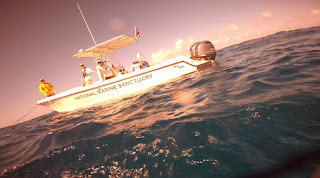Graduate Assistant
College of Marine Science, University of South Florida
Primary Advisor: Frank E Muller-Karger1
Committee: Steve Gittings2 and Dr. Christopher D. Stallings1
1College of Marine Science, University of South Florida, St Petersburg, FL 33701
2Office of National Marine Sanctuaries, NOAA, Silver Spring, MD 20910
The composition of marine ecosystems are impacted by human activities and changing climate. In order to preserve natural resources provided by marine ecosystems it is vital to understand how the marine environment is changing over time. The Florida Keys National Marine Sanctuary (FKNMS), Flower Garden Banks National Marine Sanctuary (FGBNMS), Monterey Bay National Marine Sanctuary (MBNMS) and Channel Islands National Marine Sanctuary (CINMS), are collaborating with the Marine Biodiversity Observation Network (MBON) as part of a national effort to monitor marine biodiversity.
Reef Fish Composition and Biodiversity by No-Take Marine Zones and Habitat Strata in the Florida Keys National Marine Sanctuary: 1999 - 2016.
Chapter 1: I sought to determine the efficacy of no-take marine zones on reef fish composition and biodiversity in the FKNMS. I analyzed and compared changes in seven community variables: 1) abundance, 2) biomass, 3) evenness, 4) richness, 5) Shannon diversity, 6) Simpson diversity, and 7) functional diversity. These indices were examined as "response variables" to temporal changes, spatial habitat structure, and no-take marine zones from 1999 – 2016 throughout the Florida Keys domain. The observations were evaluated for different levels of protection and were segmented across high relief reefs, linear reefs, and patch reefs habitats (i.e. the strata).
The ultimate objective of the study was to better inform management and policy in the face of growing pressures from environmental change and human uses of resources. The hypotheses that guided the study were as follows: 1) Biodiversity is greater within no-take marine zones compared to outside these zones. Marine Protected Areas that are closed to all fishing and extraction uses are expected to have a range of benefits including enhancing marine ecosystem biodiversity (Bohnsack & Ault 1996, Bohnsack et al. 2004). 2) The indices are positively correlated to habitat strata, where more complex habitats have greater diversity. Species richness and abundance are known to increase with habitat complexity providing reef fish with shelter and foraging grounds (Luckhurst & Luckhurst 1978, Gratwicke & Speight 2005).
Comparison of environmental DNA and Visual Surveys of the Florida Keys Vertebrate taxonomic Identification
Chapter 2: This study aims to overcome the many variables along the analytical pipeline to determine if environmental DNA (eDNA) can be used to adequately monitor reef fish biodiversity in coral reef ecosystems. The study is guided by the hypothesis: eDNA can be used to reflect the taxonomic composition of reef fish communities along the Florida Keys reef tract. To test this hypothesis, we collected water samples in the Florida Keys National Marine Sanctuary (FKNMS) from April 2015 to September 2016 for processing and analysis and then compared the species detected to data obtained from SCUBA methodologies. The results will be used in collaboration with the Marine Biodiversity Observation Network (MBON), a five-year project that collects and processes eDNA in the FKNMS. The study further compliments the MBON objectives to determine if novel genetic techniques can be used to synoptically assess the characteristic biodiversity within the sanctuary as well as help update the FKNMS Condition Reports on the status and trends of biodiversity.
 |
| Collecting and filtering water samples along the Florida Keys on the R/V Walton Smith. |
 |
| (Left to Right) Brady Booton, Lonny Anderson, Bill Goodwin, Kelsey Jeffers, Megan Hepner, Nancy, and Enrique Montes sampling water at Molasses Reef, Looe Key, and Western Sambo in August 2015 |
Research scientists at the FKNMS are using a hand deployed niskin bottle to sample water at Molasses Reef. The niskin bottle is lowered to a meter above the seafloor and sends a messenger down, which springs the caps on the two ends of the niskin bottle shut. Watch the curious filefish follow the niskin bottle to the surface.
A time series capturing research scientists aboard the R/V Walton Smith collecting and filtering water samples along the Florida Keys Reef tract in July 2015.
This work was supported by the NASA grant NNX14AP62A ‘National Marine Sanctuaries as Sentinel Sites for a Demonstration Marine Biodiversity Observation Network (MBON)’ funded under the National Ocean Partnership Program (NOPP RFP NOAA-NOS-IOOS-2014-2003803 in partnership between NOAA, BOEM, and NASA).









